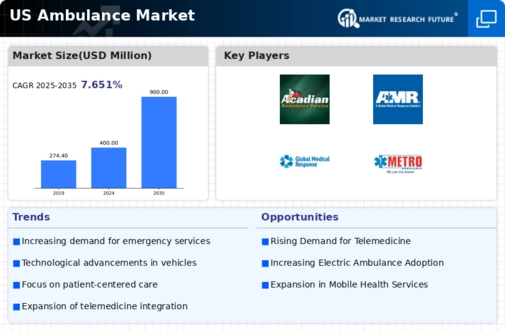The competitive landscape of the US Ambulance Market is characterized by a diverse range of service providers that cater to both urban and rural communities, each vying for a larger market share. The market is primarily segmented into private and public ambulance services, with each segment demonstrating its own unique strengths and challenges.
As healthcare needs evolve, ambulance service providers are increasingly focusing on enhancing their operational efficiency, leveraging advanced technology and training, and forming strategic partnerships to improve response times and service delivery.
The competition is further intensified by regulatory frameworks and the need for compliance with healthcare standards, which shape the operational practices of these providers.
Additionally, consumer expectations for quick and effective emergency services continue to drive innovation and competition, pushing companies to differentiate themselves through superior customer service and advanced medical capabilities.
Falck USA is a significant player in the US Ambulance Market, distinguished by its robust operational infrastructure and commitment to high-quality emergency medical services. With a strong emphasis on training and the deployment of skilled personnel, Falck USA manages to maintain a competitive edge through its effective service delivery model.
The company focuses on providing both emergency and non-emergency medical transport, ensuring its readiness to respond to diverse healthcare needs. Its presence in various states allows for regional adaptability, enabling the company to cater to local demographics effectively.
By continuously investing in advanced equipment and technology, Falck USA strengthens its operational capabilities, ensuring rapid response times and comprehensive care. Furthermore, the organization's reputation for efficient patient transfers and community engagement enhances its credibility and desirability in the market.
Rural/Metro Corporation operates within the US Ambulance Market as a prominent provider of emergency medical services, with a particular focus on rural and suburban areas that often have limited access to healthcare. The company offers a wide range of services, including emergency ambulance transport, non-emergency medical transportation, and community training programs.
Its strategic presence allows Rural/Metro to address the unique challenges faced by rural communities, where timely medical response is crucial. The company has established firm partnerships with local governments and health systems, enabling it to participate actively in community health initiatives and emergency response planning.
Through various mergers and acquisitions, Rural/Metro has expanded its service offerings and geographic footprint, enhancing its market position significantly. The company’s commitment to service excellence, reinforced by a dedicated workforce and community involvement, solidifies its reputation as a trusted provider in the US Ambulance Market.















Leave a Comment